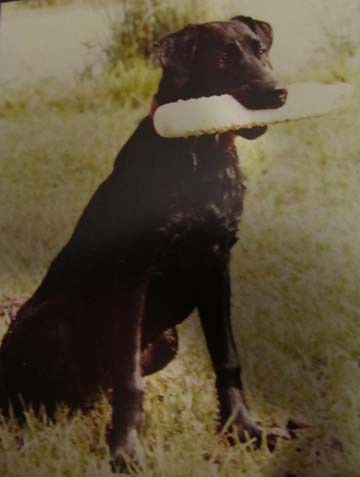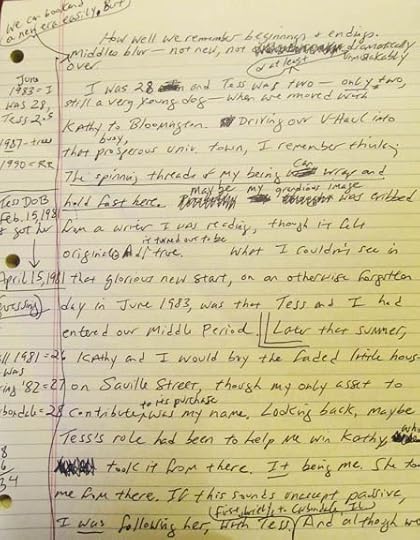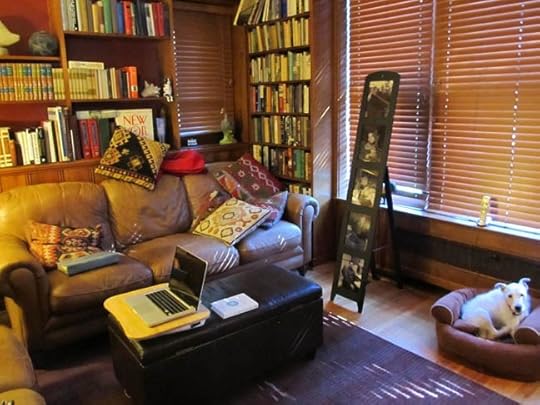Learning to sit

[Nice place to write? Photo by Sarah Elizabeth Bailey in Aigues Mortes, southern France, Aug. 2016.]
Writing means hanging in there & discovering. Until a piece is done.
So a writer comes to the page with vision in her heart and craft in her hands and a sense of what a story might be in her head. How do the three come together? My thesis is the old one: they merge in the physical writing—inside the act of writing, not from the outside. The process is the teacher. . . .
The writer is the person who stays in the room.—Ron Carlson, Ron Carlson Writes a Story

[Tess with her beloved bumper.]
In the fine short book Ron Carlson Writes a Story (reviewed), the writer takes us with him as he writes a short story in real time at his desk. There are crises and desires to flee. Also steady work and unforeseen breakthroughs. I’ve thought of Carlson as I’ve worked on my new essay, “Tess,” about my late, beloved Labrador. As I explained in my last post on this essay, the story’s meaning is elusive at this point. Discovering that meaning is what makes writing challenging but addictive to me.The essay’s structure is roughed out, though subject to change. Don’t you almost have to have some structure in mind to start something? Experience gives you a better notion, perhaps, but the actual form and content shift in construction. I have the start drafted and most of the middle and end of “Tess.” I’ve been kind of stuck in finishing the middle’s first draft. I’ve stared at my jotted plan for the last part of this part, a few words, and haven’t felt it. But I’m there to write, so I jump to the essay’s start or its ending to fiddle and add. I know if I show up every day, my subconscious is going to cry uncle and help.
Here’s another snippet of “Tess”—like last week’s excerpt it’s from the essay’s final section, a part of it that’s in second-person address:
Before ice covers the Olentangy River, just a few blocks from your building, you’ll take Tess every afternoon to swim and fetch her Frisbee. The winter will be long for a Florida boy, but you’ll be cozy reading inside with Tess lying nearby on the thin carpet. You aren’t just a broke graduate student, his thick hair starting to thin, living in a clean but threadbare apartment: you’re a guy with a great young dog who loves and needs you. Once she growls at you when you take away her juicy steakbone, and you throw her down, yell into her face, teaching her humans have such rights. Once you blow air at her with your new hair dryer, and when you’re at school she chews it to pieces, teaching you dogs have rights too.
I laughed when I wrote those last two lines yesterday. I’m not sure if I’ll use the time Tess ate a box of NoDoz (caffeine pills) when we stayed overnight at a brother’s while on a road trip. What a night we had! Meantime I’m grateful for yesterday’s little breakthrough. I hadn’t known where, or if, I’d work in the anecdotes of the bone and the dryer. I sure hadn’t planned their juxtaposition and certainly hadn’t seen their amusing relationship when I started writing.
Actually I didn’t feel like writing yesterday. So I set a low bar, told myself I’d just read the essay through. But I’ve learned, with Carlson, that showing up is what matters over the long haul. Showing up gets a piece going and, one day, gets ‘er done. Here’s some ideas that have been helping me to sit there:
Try to be the best version of yourself you can be. Take care of yourself as a human being; be nice to others, if you possibly can. Own your passion and be thankful for it. Inwardly pretend you’ve succeeded wildly at this thing you love. Because if you’re doing it, you have. And because: if it had already made you famous or successful, would you be happier and nicer? Maybe, right? Self-actualized and all that? Then pretend it happened. Meantime, keep creating. Which you’d be doing if you had become all the rage at 29. Right?

[An early page of “ Tess.”]
Change your location by writing in a different place or way. I usually compose on the computer keyboard at home, so writing in a coffee shop can make me feel more creative. Once in a while, so does writing by hand. But that lasts only briefly, because I hate my handwriting, and I’m prone to hand cramps after years of copious note-taking as a reporter. But if I feel more creative I am more creative. Dani Shapiro says in Still Writing: The Perils and Pleasures of a Creative Life (discussed) that she always hand-writes her first 30 or 40 pages. Lots of writers say they do, to slow down, to enjoy the tactile, to feel more creative. For good and ill, computers make writing look processed, not handmade; computers are cold and dead. Things you can hold like paper and pen or pencil feel alive; they might tap a different part of your brain.
Change your font. Lovely Baskerville is a recent fave. And so is zooming the display on my computer. Right now I’m writing my essay on Tess in the elegant Garamond serif typeface, enlarged to 16 points, with Word’s display zoomed to 225%. Wow, neat: big fat pretty words. Not the same boring Times New Roman I submit work in. Some pieces—usually less traditional ones, and always this blog—I write in Gill Sans, a delightful sans serif. With my computer’s view vastly enlarged these days, I feel like a mouse tiptoeing among tall buildings. Words. I can circle them, looking up. Gauge the distance to the next block of buildings. I feel myself pulled into this city of words, pulled into the story I’m assembling.
Change your rhythm. Write for 45 minutes and break for 15. During break, no email and the like—instead, I walk around, look at the yard, drink coffee, pull a few weeds, sweep the porch, collect my laundry. I love this, as ideas often flood in during the 15 minutes. My desired total session is three hours, which usually results in three new pages. Usually I take only two 15-minute breaks, skipping it for the last hour, so I get in two-and-a-half hours of work in my three-hour session. Gillian wrote about this technique on Life Moves.
Regardless: read. Especially when stuck or procrastinating. Reading comforts; reading teaches; reading (eventually) inspires. I love Heather Sellers’s advice in Chapter After Chapter (discussed) to pick out three books you want to emulate and read them while you work. Repeatedly reread and study them. I did that when writing my book—a whole series of triplets over those years of writing and revision. Sometimes with an essay I use three model essays. Lately Shapiro’s Still Writing has encouraged me because it’s about living with the emotional rollercoaster of regular writing.
[Next: Do you “vomit draft” or feel your way? What’s best? Why?]

[Where I write lately in our university-owned house. Note: reading-writing board under laptop—found at Barnes & Noble, it makes your lap a comfy desk.]
The post Learning to sit appeared first on Richard Gilbert.



